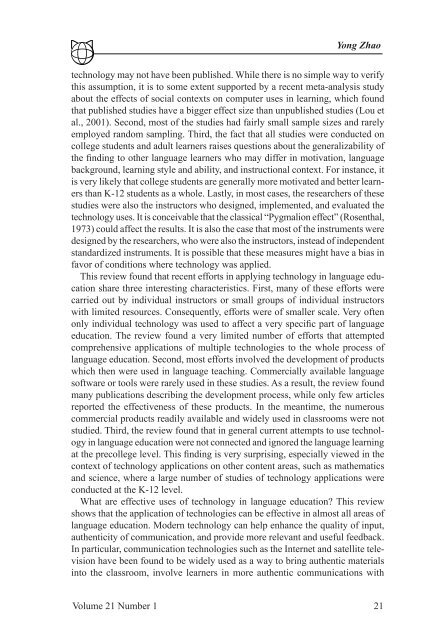Recent Developments in Technology and Language ... - CALICO
Recent Developments in Technology and Language ... - CALICO
Recent Developments in Technology and Language ... - CALICO
You also want an ePaper? Increase the reach of your titles
YUMPU automatically turns print PDFs into web optimized ePapers that Google loves.
Yong Zhao<br />
technology may not have been published. While there is no simple way to verify<br />
this assumption, it is to some extent supported by a recent meta-analysis study<br />
about the effects of social contexts on computer uses <strong>in</strong> learn<strong>in</strong>g, which found<br />
that published studies have a bigger effect size than unpublished studies (Lou et<br />
al., 2001). Second, most of the studies had fairly small sample sizes <strong>and</strong> rarely<br />
employed r<strong>and</strong>om sampl<strong>in</strong>g. Third, the fact that all studies were conducted on<br />
college students <strong>and</strong> adult learners raises questions about the generalizability of<br />
the f<strong>in</strong>d<strong>in</strong>g to other language learners who may differ <strong>in</strong> motivation, language<br />
background, learn<strong>in</strong>g style <strong>and</strong> ability, <strong>and</strong> <strong>in</strong>structional context. For <strong>in</strong>stance, it<br />
is very likely that college students are generally more motivated <strong>and</strong> better learners<br />
than K-12 students as a whole. Lastly, <strong>in</strong> most cases, the researchers of these<br />
studies were also the <strong>in</strong>structors who designed, implemented, <strong>and</strong> evaluated the<br />
technology uses. It is conceivable that the classical “Pygmalion effect” (Rosenthal,<br />
19 3) could affect the results. It is also the case that most of the <strong>in</strong>struments were<br />
designed by the researchers, who were also the <strong>in</strong>structors, <strong>in</strong>stead of <strong>in</strong>dependent<br />
st<strong>and</strong>ardized <strong>in</strong>struments. It is possible that these measures might have a bias <strong>in</strong><br />
favor of conditions where technology was applied.<br />
This review found that recent efforts <strong>in</strong> apply<strong>in</strong>g technology <strong>in</strong> language education<br />
share three <strong>in</strong>terest<strong>in</strong>g characteristics. First, many of these efforts were<br />
carried out by <strong>in</strong>dividual <strong>in</strong>structors or small groups of <strong>in</strong>dividual <strong>in</strong>structors<br />
with limited resources. Consequently, efforts were of smaller scale. Very often<br />
only <strong>in</strong>dividual technology was used to affect a very specific part of language<br />
education. The review found a very limited number of efforts that attempted<br />
comprehensive applications of multiple technologies to the whole process of<br />
language education. Second, most efforts <strong>in</strong>volved the development of products<br />
which then were used <strong>in</strong> language teach<strong>in</strong>g. Commercially available language<br />
software or tools were rarely used <strong>in</strong> these studies. As a result, the review found<br />
many publications describ<strong>in</strong>g the development process, while only few articles<br />
reported the effectiveness of these products. In the meantime, the numerous<br />
commercial products readily available <strong>and</strong> widely used <strong>in</strong> classrooms were not<br />
studied. Third, the review found that <strong>in</strong> general current attempts to use technology<br />
<strong>in</strong> language education were not connected <strong>and</strong> ignored the language learn<strong>in</strong>g<br />
at the precollege level. This f<strong>in</strong>d<strong>in</strong>g is very surpris<strong>in</strong>g, especially viewed <strong>in</strong> the<br />
context of technology applications on other content areas, such as mathematics<br />
<strong>and</strong> science, where a large number of studies of technology applications were<br />
conducted at the K-12 level.<br />
What are effective uses of technology <strong>in</strong> language education? This review<br />
shows that the application of technologies can be effective <strong>in</strong> almost all areas of<br />
language education. Modern technology can help enhance the quality of <strong>in</strong>put,<br />
authenticity of communication, <strong>and</strong> provide more relevant <strong>and</strong> useful feedback.<br />
In particular, communication technologies such as the Internet <strong>and</strong> satellite television<br />
have been found to be widely used as a way to br<strong>in</strong>g authentic materials<br />
<strong>in</strong>to the classroom, <strong>in</strong>volve learners <strong>in</strong> more authentic communications with<br />
Volume 21 Number 1 21
















